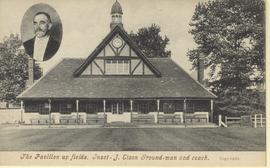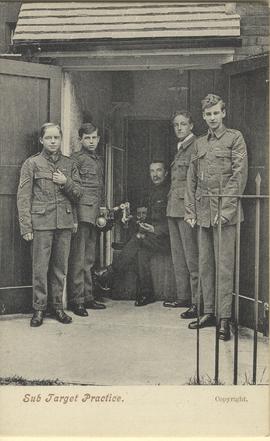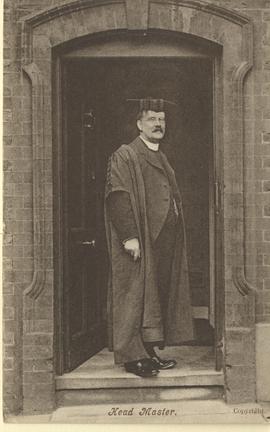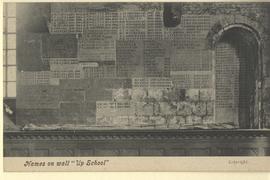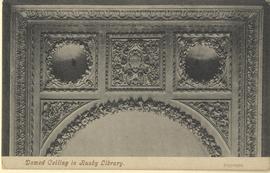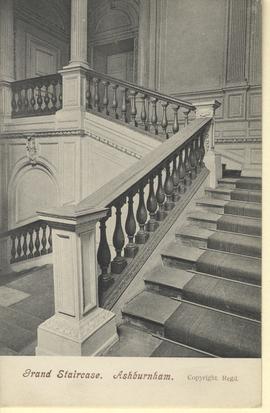One copy annotated on reverse by R.S. Chalk as follows:
'Memories 1918-1921 (thereafter to Water)
By 1918 Elson was a venerable, silver-haired figure up Fields, yet with many years still to go. Over his many years he prepared and maintained a first-class Cricket Pitch. We were of opinion it was the second best in London - “Better than Lord’s, second only to the Oval”. Be that as it may, I head “Plum” Warner assure us (at a lecture up School in Election 1920) that one reason why we lost so many matches was that Vincent Square provided such excellent pitch within easy reach, so attracted many leading London cricketers; he also appreciated the sumptuous tea provided not only for Teams but to all visitors. (My only memory of Elson is bowling in nets)
Before the acquisition of the Boat House (1921) and Grove Park, pressure up Fields in summer was extreme. Boarders not in the Corps (I for one) played Cricket 5 days in the week, and watched a School Match on Saturday. I have memories of 7 games in progress simultaneously along the S. side of Fields. Once a terrific swipe from the end-most pitch narrowly missed me at square-leg. I had to chase it across six pitches, being cursed at each for interrupting the play! (Tho’ never a player of any mark, I nonetheless retain a love for Cricket!)'
One copy annotated on reverse by R.S. Chalk, as follows:
'1918-1922
I do not remember any public Gym Displays in my time.
The Instructor in the picture is presumably Sgt. Melican. About 1915 he was succeeded by the colourful Sergeant Satchell - barrel chest, waxed moustache and prominent blue eyes. He was immensely popular, not least on account of his lurid descriptions (e.g. how to withdraw a bayonet from the body of a dead German), as also his vivid and racy anecdotes. E.g. “I hit ‘im square between the eyes. ‘Is eyes popped right out on strings, criss-crossed 2 or 3 times, then went back.”
Or his account of an incident during a boxing-bout between G.O. George, K.S, and A.L. Haskell (RR), now of Sadler’s Wells Ballet:
“George caught ‘im one right on the side of the nose [in those days an out-size one, tho’ later pruned]. ‘Is nose went right over at a right-angle- and came back with a click!”'
One copy annotated on reverse by R.S. Chalk, as follows:
'1918-1924
I am not certain what ‘Sub Target Practice’ implied. The ‘diamond’ badge on the right sleeves of the two corporals was a proficiency badge - I believe gained by passing ‘A Cert’. By 1918 slacks (as in the picture) had given place to breeches and puttees, worn by all in uniform.
This picture is particularly valuable as providing a good portrait of the excellent Sergeant Bowler, School Sergeant 1900-1936 one of that magnificent band of School Servants etc who served the School so faithfully for the first quarter of this Century. ‘Sergeant’ was the friend of all, except the recalcitrant. By 1918 he had ceased to have anything to do with the A.T.C. - his parades were limited to twice-weekly Penal Drill (a salutary corrective and deterrent, abolished by H.C.W. about 1923). ‘Sergeant’ was always on duty. I believe I last met him up School in the Spring of 1936 - if so, only a few weeks before his death on 9.4.1936- in harness.'
One copy annotated on reverse by R.S. Chalk, as follows:
'1. Dr. JAMES GOW (‘Jimmy’), H.M. 1901-1919
My first meeting with him was at Challenge 1918. I owe him a lifelong debut for his accepting me without Common Entrance Exam (on the strength of my dismal Challenge papers), thus saving a second journey from my home in Devon in War-time conditions.
My first three Terms (Play 1918-Election 1919) coincided with his last three. He had been a great and good HM, but was now almost blind and moved in a dignified daze, piloting himself with a stick. (Intent on my prep, I once collided with him in Yard)
Through no fault of his, School discipline had become somewhat lax by 1918. Leave and Plays were easily given (e.g. to go skating on the Serpentine in Lent 1919).
He was much loved and his departure was a solemn occasion. He shook hands with every boy after his last Prayers. I am glad I remembered to say ‘Thank you, Sir’ – with the classical Remove form-prize in my hand.'
Depicts Burlington Arch in Little Dean's Yard.
One copy is annotated on reverse by R.S.C as follows:
'The focal point of Yard, which impressed me deeply when I first saw it (as a small boy in 1915). I wondered even then how boys could carve their names on it so expertly. (Later Mr. Green carved my name in College on wood for (I believe) the sum of 5/-).
The centre-piece of many a School compilation. (A tragedy the present ‘Eliza’ has no use for it).
In my day it was wrongly known by Town Boys in Under School as the ‘Up School Gateway’ (save the mark!). A new Junior KS. of my Election in his word-test called its designer ‘Jingo Jones’.
To the left is Sergeant’s Office (a ‘sanctum sanctorum’ where were compiled lists of those due for ‘Up School’ or Penal Drill), with the VI Form Room above it. To the right, in my day a convenient but ugly Fives Court, used (exclusively, I think) by K.SS. It was a vast improvement aesthetically when this was removed some years later and the vista opened into (hitherto unseen) College Gardens.'
One copy annotated on reverse as follows, by R.S. Chalk:
'1918-1924
By the 1920’s the multiplication of names of O.WW up School was beginning to pose a real problem, as space was running short. They cost (I believe) only 5/- Each!
Towards the end of my time I heard Costley-White explaining to some distinguished visitors that in future permission to have names painted up School was to be confined to “Westminster Families”, i.e. families that had at least three members at the School at some date. I could claim a younger brother and, later, three cousins – but in any case all was decided by the Blitz (which obliterated hundreds of names, including 17 Phillimores and 16 Waterfields).'
One copy annotated by R.S. Chalk on reverse, as follows:
'R.S.C. Memories 1922-1924
The destruction of this superb ceiling (I believe by an H.E. bomb earlier in the Blitz than the gutting of School) was a calamity indeed.
It was a great relief to O. WW once of the VII to know that it was so expertly replaced after the War- its moulding including the Redstart which had nested in the ruins during the Exile.
I sat under this ceiling for my two years in the VII 1922-1924 and (with many another) frequently admired its beauty.
The details of the moulding were so delicate and detailed that we were of opinion (I think wrongly) that it could not be plaster- work, but must be wood-carving white washed over.
The VII Form Room was also used out of School for meetings of Deb. Soc, but I think for no other recreational purpose. Also, on rare occasions, by the School Monitors in trying a case referred to them by the H.M.'
One copy annotated on reverse by R.S. Chalk, as follows:
'Memories 1921-24
(Known to us erroneously as ‘College Gardens’)
It was anomalous (to say the least) that this delectable adjunct to the School should have been debarred even to K.SS except on two days of the year (for the reason, see L.E. Tanner, p46) while (before the opening up of the vista between School and College) TBB never set eyes on it! The Garden was not then visible from Dormitory (windows being too high up) but a distant glimpse of the Canons disporting themselves there could be gained from a window up Saignes.
KSS were allowed into the Garden for a few blissful hours on Election Sunday and again next morning for Juniors’ Race, when Juniors ‘ran for their freedom’. This consisted of a handicap race twice round the Garden. A handsome money prize was awarded to the first three finishers (provided no doubt from Election ‘Cap’). (My luck to be pipped on the post by Binyon for 3rd place!). The disgusting custom of ‘Feeding’ in Hall before the Race was mercifully abolished by that wise Chaplain R.C. Fisher in my year (1921).'
One copy annotated on reverse by R.S. Chalk, as follows:
'This picture (well before my time) has its use in supplying a general date for this series of P.C.s (recorded in Record of OWW Vol III, under ‘Arthur Brown’ on p443 as “about 1911”).
It is always a source of regret that it was never my lot as a KS to take part in our supreme privilege of all - being first in the Empire to proclaim the Sovereign at a Coronation.
The only royal occasions in which I was able to take part were (1) Princess Mary’s Wedding in 1922 as a (very nominal) Steward at the North Door and (2) the Installation of the Knight’s of the Bath in 1923 or 1924. At this my companion and myself were Stewards with the task of checking tickets at the little North Aisle door, commonly called ‘Devil’s Door’. L.E. Tanner, in charge, posted us with the words “Now come along, you two Devils!”'
One copy annotated on reverse by R.S. Chalk, as follows:
'1918-1924
In those days Ashburnham Staircase was regarded as a ‘nine days’ wonder’ and considered so exceedingly precious that we boys were only allowed to use it once every three years - at ‘Commem’. I have memories of walking up it for the first time on Nov 17, 1919 and again that date in 1922. We walked in wonder and awe, but there was such a crush we could hardly appreciate its beauty. Towards the end of my time (presumably after A.T. Willet became Librarian in 192__) regulations were relaxed and the Staircase was more frequently opened. But it then ceased to bear its former ‘inaccessibility’ charm!'
